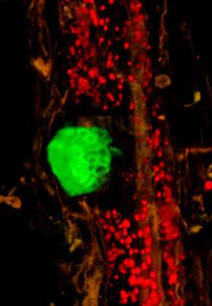The group of Dr. Yori Leshem, in the department of plant science, studies (among other topics) the response of plants to salinity. Recently they found that young lateral roots (LR) are much more tolerant to lethal salinity than older (primary) roots (PR). It was long assumed that the whole root dies at this salt concentration within few hours. Dr. Leshem’s group found that the LR remains alive even after 4 days of salt stress. This discovery can lead to identification of novel salt stress coping mechanisms needed by agriculture for coping with the soil salinization challenge, which is predicted to get worse.
The research was performed in the model plant Arabidopsis thaliana. While the PR died, emerging and young LR remained strikingly viable. The picture shows a representative confocal microscopy fluorescent image of Arabidopsis root stressed with 200 mM NaCl. Red dots in the PR indicates dead cells, while the green “island” indicates viability of a young LR.
More information is available at:
Ambastha, V., Friedmann, Y. & Leshem, Y. Laterals take it better – Emerging and young lateral roots survive lethal salinity longer than the primary root in Arabidopsis. Sci. Rep. 10, 1–11 (2020).

